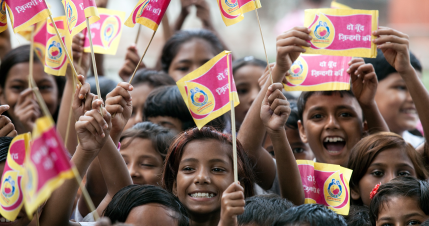- Passing on the Polio legacy- Social Mobilization Network Deployment to new locations
- Guidelines for the use of the Communication kit for the tOPV to bOPV SWITCH
- tOPV to bOPV SWITCH FAQs for Cold Chain Handlers and ANMs-English
- tOPV to bOPV FAQs for Cold Chain Handlers and ANMs-Hindi
- tOPV to bOPV SWITCH Fact Sheet-English
- tOPV to bOPV SWITCH Fact Sheet-Hindi
- tOPV to bOPV SWITCH Segregation Tape-Bilingual
- tOPV to bOPV SWITCH job aid for Cold Chain Points-English
- tOPV to bOPV SWITCH job aid for Cold Chain Points-Hindi
- tOPV to bOPV Poster for Cold Chain Points-English
- tOPV to bOPV Poster for Cold Chain Points-Hindi
- E-Brochure: Before the tOPV to bOPV SWITCH
- E-Brochure: After the tOPV to bOPV SWITCH
- SMSes for tOPV to bOPV SWITCH
Polio Immunization Campaigns
National Immunization Days
National Immunization Days (NIDs) are held across India twice a year, with the Government of India setting out to give two drops of oral polio vaccine (OPV) to every child in the country under the age of five. The scale is extraordinary, with more than 172 million children immunized by 2.3 million vaccinators who visit every house in every city, town and village across the country – more than 209 million houses in all.
Sub-National Immunization Days
Several Sub-National Immunization Days (SNIDs) are also held annually in the highest-risk states, including Uttar Pradesh, Bihar, West Bengal and areas most at risk of a polio outbreak, due to underlying factors such as poor sanitation, high population density, a high enteric disease burden, a general lack of services and low rates of routine immunization. On average, more than 70 million children are vaccinated in each SNID.
Booth Day
In the states of Uttar Pradesh and West Bengal, polio campaigns are launched with ‘Booth Day’ on ‘Polio Sunday’, where thousands of fixed site booths are set up throughout the neighbourhood for children to be brought to receive OPV. Once vaccinated, each child has the little finger on their left hand marked with a permanent marker and in many locations are also given a nutritional supplement, a paper sun-visor or mask, a ball and a whistle. In UP, a children’s brigade called the ‘Bulawa Toli’ (or ‘Calling Troupe’) parades through the neighbourhood waving flags, blowing whistles and calling out polio vaccination slogans, inviting younger children to the booth to receive OPV.
Visiting Every House
From Monday to Thursday, vaccination teams go door to door to every house, checking each child under five to see if their left little finger is marked, and if not, vaccinating them with OPV. If a child is not home, or a parent refuses vaccination, the outside of the house is marked with an X, and recorded in a register, for the ‘B’ team to return to that afternoon. If the ‘B’ team is also unsuccessful in reaching the child, a third team visits at the conclusion of the round to attempt to sweep up any missed children.


